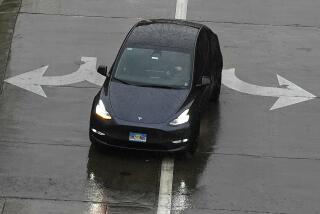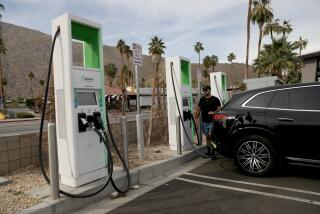Ford sales decline only 11% in June
For a key indicator of industrial strength and consumer confidence, a 28% year-over-year decline would seem nothing short of disastrous.
But when that indicator is automobile sales, and that industry has been slogging through its worst run in decades, a 28% slide somehow doesn’t seem that bad.
In June, Americans bought 859,847 cars and light trucks, according to data released by automakers Wednesday and compiled by Autodata Corp. That’s the smallest monthly sales falloff since September. And even though the industry hasn’t seen a sales increase in nearly two years, it was enough for executives to begin -- ever so cautiously -- to spot green shoots amid the rusted steel.
“The tide seems to have shifted in recent weeks,” said Jim Farley, head of marketing and communications at Ford Motor Co., the only American automaker not to have taken government bailout funding.
The nation’s second-largest automaker saw its sales decline just 11% from a year earlier. That’s by far the best performance of any major automaker, a performance Farley attributed to the quality of its new vehicles rather than to any gains from disgruntled former customers of troubled General Motors Corp. and Chrysler.
And though GM and Toyota Motor Corp. saw more substantial drops, of 33% and 32%, respectively, both enjoyed improvement over recent months’ results, which rank among the weakest in their histories. That prompted executives at the two automakers to suggest that the worst was officially behind.
“We feel pretty strongly that the bottom was hit earlier in the year,” said Mark LaNeve, head of sales, service and marketing at GM, who fingered February, when sales declined 41.4%.
With the long-anticipated bankruptcies of Chrysler and GM behind, even the analysts seemed ready to call the end of bad times. “It is unlikely things will get any worse,” said Jesse Toprak, head of industry analysis at Edmunds.com.
Not that June was all that great.
Chrysler Group, now controlled by Italian automaker Fiat, saw its sales fall 42% in a month in which it shut down 789 of its dealers. Honda Motor Co. saw its sales decline 30% compared with June of last year. Nissan Motor Co. and Hyundai Motor Co. managed to look downright respectable because they each bagged sales declines of less than 25%.
Ford and Toyota, calling a recovery, even bragged of plans to boost production in the third quarter, and several companies mentioned improved consumer credit despite the fact that it’s nearly impossible to get a car loan with a credit score below 720 these days.
Optimism aside, the market continues to hover far below what would have been called depressed levels a year ago. On an annualized basis, sales in June hit a level of 9.7 million units, according to Autodata, 40% below the industry’s sales rate for most of this decade.
Moreover, sales of domestic and import brands remained weak in several key regions. Chief among them is California, the nation’s largest auto market. Even Toyota, practically the home team in the Southland, had trouble selling cars in the Golden State last month.
“The overall industry is doing worse in California than anywhere else in the country,” said Bob Carter, Toyota’s U.S. general manager.
A year ago, the industry was on pace to sell 13.6 million vehicles. But the soaring price of gasoline, which peaked in July 2008, hammered vehicle sales, prompting industry executives to predict impending disaster.
Those predictions were on target, and the last 12 months have been the most brutal, in terms of sales, that the industry has faced in at least three decades. For all of 2008, sales declined 18%. Through the first five months of this year, they were down 37%.
Now the same executives are hoping that a fresh set of predictions will prove as prophetic: Automakers are calling for improved sales in the third and fourth quarters that would pull the full-year results up to about 10.5 million cars and light trucks sold.
For that to happen, however, a number of attempts to jump-start sales have to work, including incentives.
GM this week announced an aggressive Fourth of July incentive program, and Hyundai promised $1.49-a-gallon gas for a year to buyers of its vehicles. Suzuki said Wednesday it would offer three months of free gas to buyers of some models.
Another boost could come from the government’s “cash for clunkers” program, which starts this month. It will allow drivers to get up to a $4,500 credit for trading in fuel-hungry older cars for new vehicles.
“We know some customers were telling us that they’re sitting on the fence in anticipation of the program,” said Toyota’s Carter, echoing the widespread sentiment that the program could bring millions of buyers back to dealerships. Chrysler said Wednesday it would even offer owners of its vehicles an extra $750 on top of the government credit if they traded up to a new Dodge, Jeep or Chrysler.
Now, at least, with GM’s and Chrysler’s worst problems apparently behind them and the federal government backing warranties on their vehicles, there is more certainty in an industry that seemed overshadowed by its financial woes.
Chrysler emerged from bankruptcy after six weeks and has a trimmer dealer network. GM is awaiting a judge’s decision about whether it can follow Chrysler’s lead and emerge from Chapter 11 as a new entity with far less debt, four fewer brands and a far smaller workforce.
“It was a good month in the face of difficult conditions,” said GM’s LaNeve. But, he admitted, “our position is tenuous.”
--






